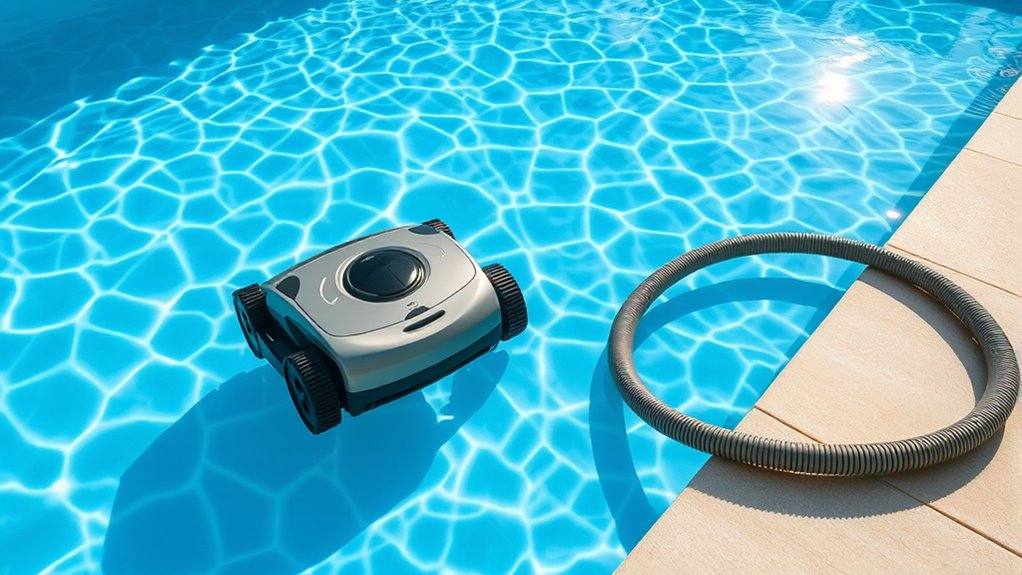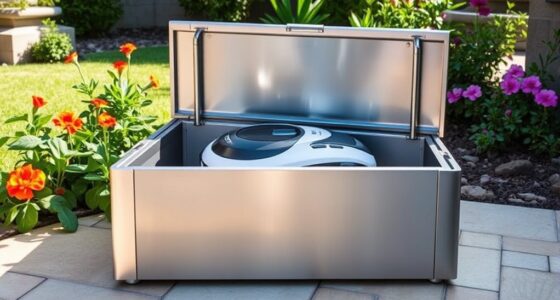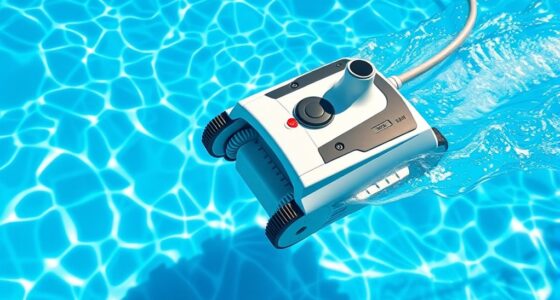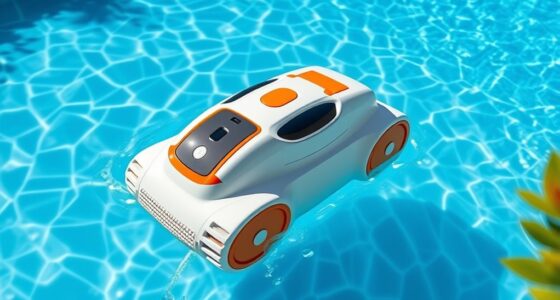Choosing between automatic and manual pool cleaning depends on your budget, effort, and desired control. Automatic cleaners offer convenient, efficient, and low-maintenance cleaning but come with higher upfront costs and occasional technical issues. Manual cleaning is budget-friendly and gives you full control but requires more time and effort. To weigh these options effectively and learn how each fits your needs, consider the detailed pros, cons, and costs outlined here.
Key Takeaways
- Manual cleaning offers full control and targeted debris removal but is labor-intensive and time-consuming.
- Automatic cleaners provide convenient, consistent cleaning with less effort but may require initial setup and maintenance.
- Manual methods have lower upfront costs but higher ongoing labor expenses; automatic cleaners involve higher initial investment but lower long-term costs.
- Automatic cleaners can disturb water chemistry and may miss certain areas, whereas manual cleaning allows precise targeting.
- Choosing depends on balancing upfront costs, ongoing maintenance, effort level, and desired control over pool cleanliness.
Overview of Pool Cleaning Methods
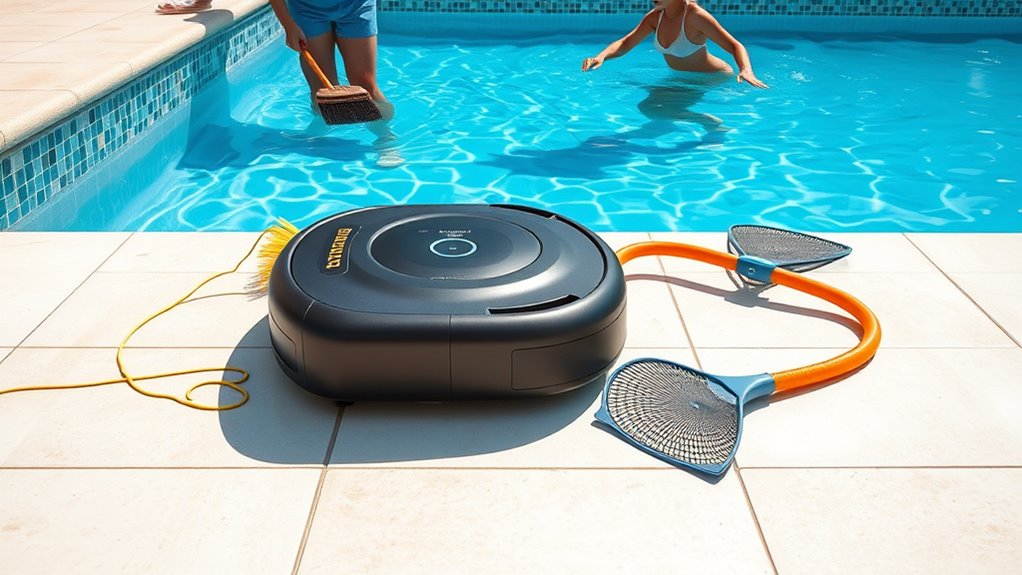
When it comes to keeping your pool clean, there are two main methods to contemplate: automatic and manual cleaning. Manual cleaning involves using tools like skimmers, brushes, and vacuums you operate yourself. It requires regular effort but offers direct control over water chemistry and ensures you spot potential safety hazards promptly. Manual cleaning can be labor-intensive, but it allows for a thorough cleaning of hard-to-reach areas. Automatic cleaners, on the other hand, use robotic or suction-based systems to clean the pool with minimal effort. They can maintain water clarity and reduce debris buildup consistently. Additionally, many automatic cleaners feature advanced navigation systems that improve their efficiency and coverage. Navigation technology enhances their ability to cover the entire pool surface effectively. Proper filter maintenance is also crucial to ensure automatic cleaners operate efficiently and prolong their lifespan. Both methods impact pool safety by preventing slips and accidents caused by debris. Additionally, maintaining proper water chemistry is easier with automatic cleaners, as they help monitor and keep your water balanced. Choosing between these options depends on your maintenance preferences and safety priorities. Proper water chemistry is essential for a healthy pool environment and can be more easily managed with automatic cleaning systems.
Benefits of Automatic Pool Cleaners
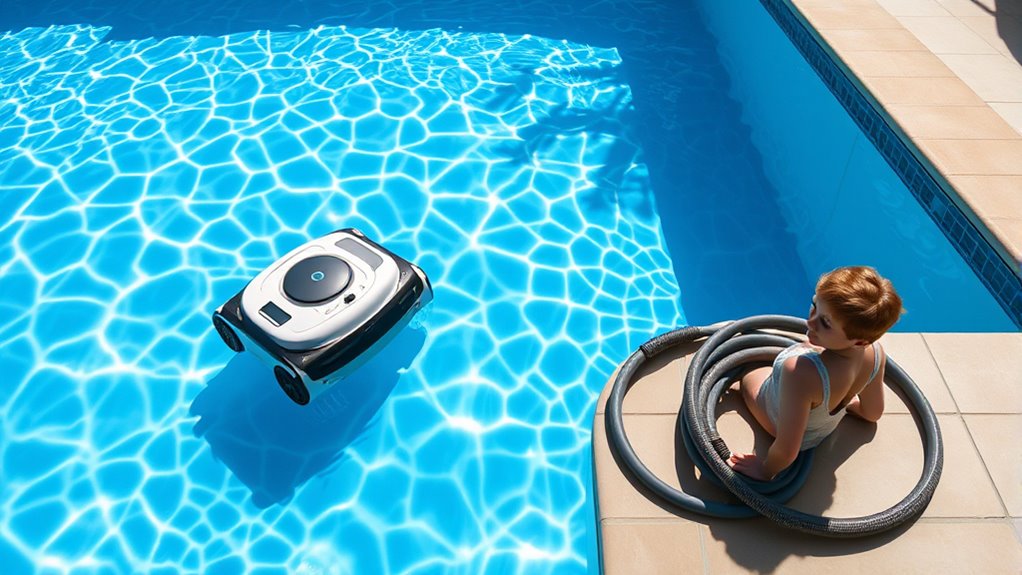
Automatic pool cleaners offer a convenient and efficient way to keep your pool spotless with minimal effort. They harness robotic efficiency, maneuvering your pool and removing debris without constant supervision. This saves you time and energy compared to manual diligence, which demands consistent scrubbing and skimming. Additionally, best tools for deep cleaning ensure thorough maintenance of your pool’s surfaces. Incorporating AI-powered maintenance systems can further optimize cleaning routines and adapt to your pool’s specific needs. Moreover, understanding the cost-effectiveness of these systems can help you make informed decisions about your pool maintenance strategy. The integration of advanced technology can also improve overall pool hygiene by systematically addressing different types of debris and contaminants. Staying informed about emerging cleaning innovations can help you select the most suitable system for your needs.
Drawbacks of Automatic Pool Cleaners

Although automatic pool cleaners offer many advantages, they also come with notable drawbacks. One major issue is their impact on pool chemical balance; some models can stir up debris or disturb the water, requiring you to adjust chemicals more frequently. Additionally, automatic cleaners tend to have higher energy consumption compared to manual cleaning, which can increase your electricity bills over time. They may also get stuck or miss certain areas, leading to uneven cleaning results. Maintenance can be another hassle, as parts like brushes and filters need regular upkeep. If you have a larger or more complex pool, these drawbacks become more significant. Moreover, choosing the right type of cleaner depends on understanding the differences between various models, including their performance and efficiency. It’s also important to consider how their digital controls can affect ease of use. For some users, the cost of maintenance can outweigh the convenience benefits, especially if frequent repairs are needed. Furthermore, automatic cleaners can sometimes damage delicate pool surfaces, which requires careful selection of compatible models. Overall, while they save time, automatic cleaners may introduce new challenges that you need to manage.
Advantages of Manual Pool Cleaning

Manual pool cleaning gives you full control over the cleaning process, ensuring your pool stays pristine without relying on complex machinery. With manual effort, you can target specific areas that automated cleaners might miss, maintaining a higher level of cleanliness. Direct control allows you to adjust your cleaning approach based on your pool’s needs, rather than a preset cycle. Here are some advantages: 1. Precision cleaning of stubborn debris and algae. 2. Ability to focus on hard-to-reach spots. 3. No dependence on electrical systems or batteries. 4. Cost-effective, with minimal maintenance costs. This method empowers you to keep your pool spotless by actively engaging in the cleaning process, giving you peace of mind that every inch is thoroughly maintained. Additionally, manual cleaning allows for a customized approach tailored to your pool’s specific requirements. Engaging in manual cleaning also provides an opportunity to inspect the pool’s condition regularly, helping you spot issues early before they become costly repairs.
Disadvantages of Manual Pool Cleaning
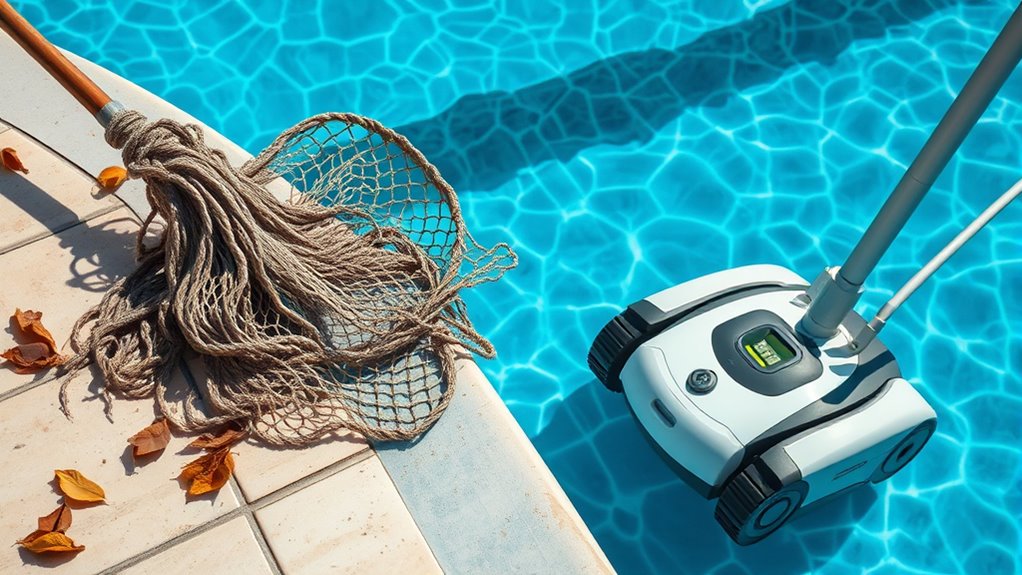
While manual pool cleaning allows for targeted and thorough maintenance, it also comes with notable drawbacks. First, it demands significant manual effort, which can be tiring and time-consuming, especially for larger pools. You’ll need to spend hours scrubbing surfaces, skimming debris, and vacuuming the pool floor. Additionally, manual cleaning often fails to remove stubborn pool scum and build-up in hard-to-reach areas, leaving your pool less clean. Inconsistent cleaning habits can lead to uneven results, and frequent maintenance can become a chore rather than a quick task. Over time, the physical effort required may cause fatigue or strain, making it less appealing for regular use. Furthermore, manual cleaning can sometimes overlook hidden contaminants, which may affect water quality over time. Proper filtration and circulation are essential to maintain water clarity and safety. Additionally, manual cleaning may not be as effective in preventing algae growth if not performed regularly. Overall, manual cleaning’s labor-intensive nature can outweigh its precision benefits, especially when considering the efficiency of automated systems.
Cost Analysis of Automatic Vs Manual Cleaners
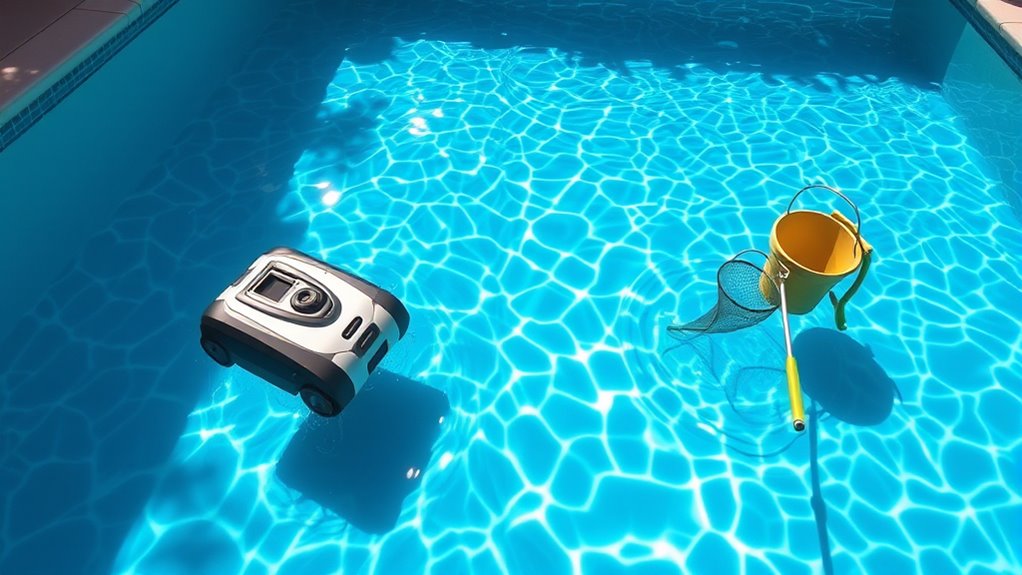
When comparing the costs of automatic and manual pool cleaners, it’s important to contemplate both upfront expenses and ongoing maintenance. Automatic cleaners typically have higher initial costs but offer better energy efficiency, reducing long-term electricity bills. Manual cleaners are cheaper upfront but can increase labor costs due to the time and effort required. Consider these points:
Automatic pool cleaners cost more upfront but save money through energy efficiency, while manual cleaners are cheaper initially but increase labor expenses.
- Automatic cleaners often cost between $500 and $1,200, while manual options are usually under $200.
- Automatic models consume less energy, saving you money over time. Energy efficiency is a key advantage of automatic pool cleaners.
- Manual cleaning increases labor costs, especially if frequent scrubbing is needed.
- Automatic cleaners reduce labor hours but may require occasional repairs, adding to maintenance costs.
- Understanding industry trends can help you choose the most suitable and cost-effective cleaning method for your pool.
Balancing these factors helps you determine the most cost-effective choice for your pool.
Maintenance and Operating Costs
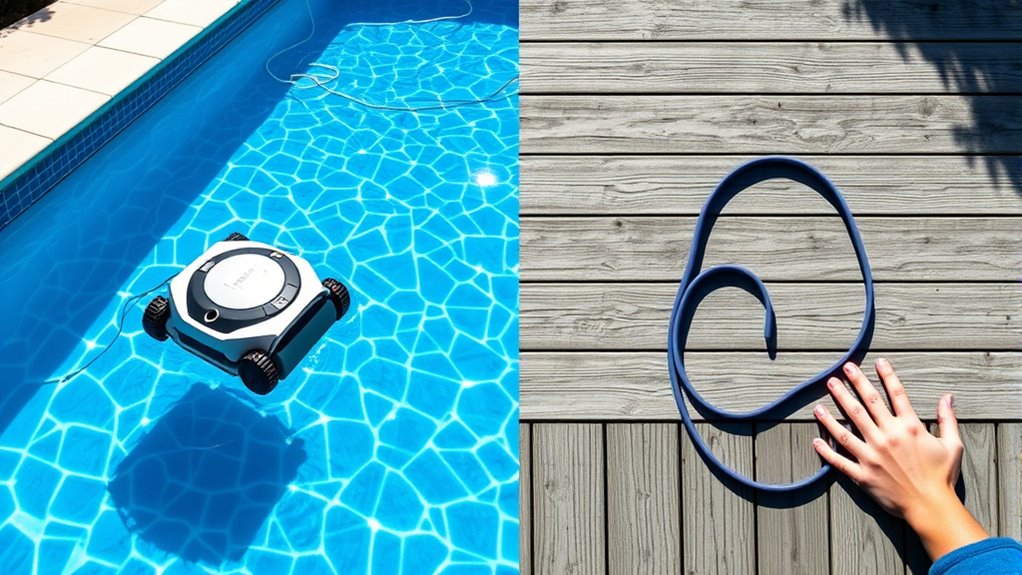
Automatic pool cleaners generally have lower ongoing maintenance and operating costs compared to manual options. They are more energy-efficient, consuming less power to operate, which helps reduce your utility bills. Additionally, they require less labor, saving you time and effort that would otherwise be spent manually scrubbing and skimming. Many automatic models have self-cleaning filters, minimizing the need for frequent maintenance. Over time, this reduces the costs associated with replacing parts or performing extensive upkeep. While automatic cleaners may have a higher upfront cost, their lower energy consumption and labor savings balance out expenses, making them more economical in the long run. Overall, automatic pool cleaners streamline maintenance, helping you keep your pool clean without breaking the bank.
Factors to Consider When Choosing a Cleaning Method
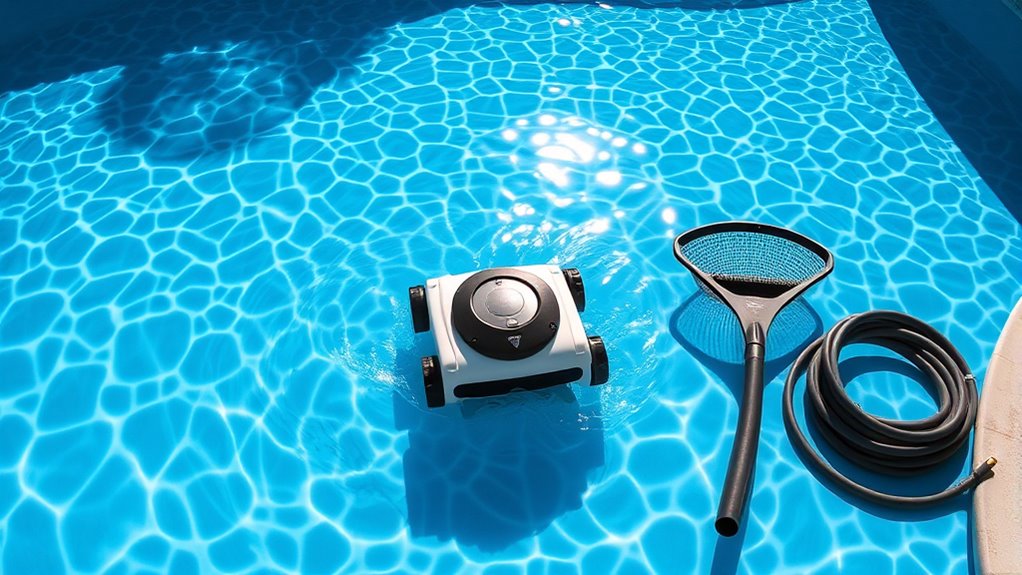
When choosing a cleaning method, you should consider the initial setup requirements and how much effort they’ll need from you. Think about the ongoing maintenance and operational tasks involved with each option to see which fits your routine. Balancing setup and upkeep can help you pick the best method for your pool.
Initial Setup Requirements
Choosing the right pool cleaning method begins with understanding the initial setup requirements, which can substantially impact your convenience and budget. For manual cleaning, you’ll need basic pool equipment like brushes and skimmers, with minimal installation effort. Automatic cleaners require more planning:
- Assess the pool equipment compatibility
- Consider the installation complexity of robotic or suction-side cleaners
- Determine space for storing and maintaining equipment
- Evaluate if electrical outlets or plumbing modifications are needed
Manual cleaning involves little setup, primarily involving cleaning tools. Automatic systems often demand more upfront work, especially for installation and integrating into existing pool equipment. Your choice depends on how much setup you’re willing to handle initially versus ongoing effort.
Maintenance and Operation
Since maintenance and operation can substantially influence your ongoing pool care, it’s important to contemplate how each cleaning method fits into your routine. Automatic cleaners often require minimal effort, saving you time and ensuring consistent cleaning, which helps maintain proper pool chemistry. However, they need regular checks to ensure equipment durability and prevent malfunctions. Manual cleaning demands more hands-on effort but allows you to directly monitor water quality and adjust your approach as needed. Consider whether you prefer the convenience of automatic devices or the control of manual cleaning. Also, think about how each method impacts your pool’s chemistry management and the longevity of your equipment. Choosing the right method depends on balancing ease of use with your ability to maintain ideal pool conditions.
Making the Right Choice for Your Pool
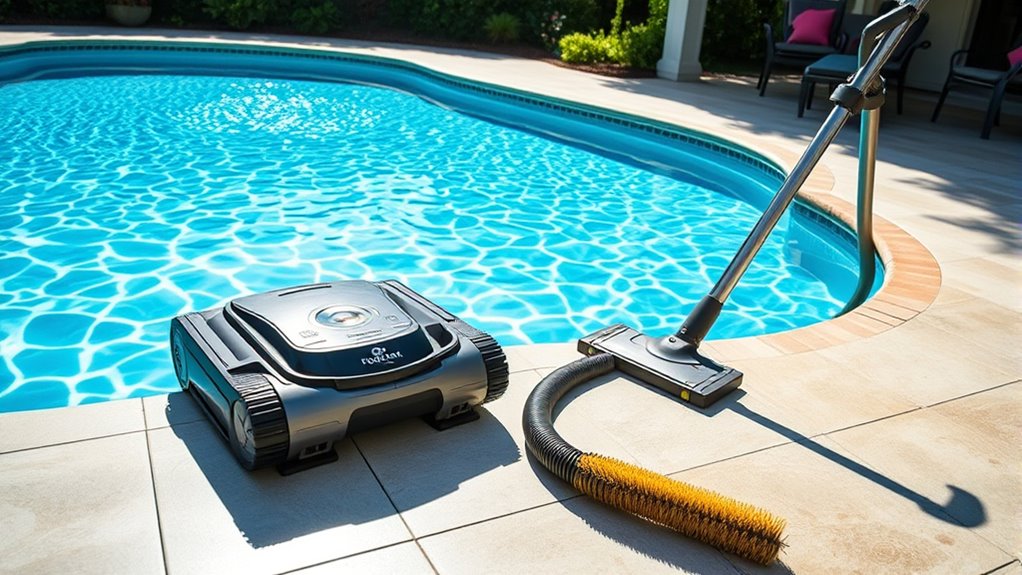
Deciding between an automatic and a manual pool cleaner depends on your specific needs, budget, and how much time you’re willing to dedicate to maintenance. To make the right choice, consider these factors:
- Energy Efficiency: Automatic cleaners often use less energy, reducing your environmental impact.
- Ease of Use: Automatic models save time but may require initial setup; manual cleaning demands more effort but offers control.
- Cost: Automatic cleaners are usually more expensive upfront, while manual tools are more budget-friendly.
- Maintenance Needs: Automatic cleaners handle regular cleaning with minimal intervention, whereas manual cleaning allows you to target specific areas more precisely.
Frequently Asked Questions
How Long Does Each Cleaning Method Typically Take?
You’ll find that robot efficiency impacts cleaning time, with automatic cleaners often completing tasks faster than manual methods. A robotic pool cleaner typically takes 1 to 3 hours, depending on pool size and debris, while manual cleaning can take 2 to 4 hours or more. Maintenance requirements for robots are usually minimal, but manual cleaning demands more effort and time to guarantee your pool stays spotless.
Can Automatic Cleaners Handle Large Debris Effectively?
Automatic cleaners can handle large debris effectively, but it depends on the debris size and your cleaner’s design. Some models are equipped with strong suction and robust brushes, making cleaning speed faster and more efficient. However, very large debris, like sticks or leaves, might clog or slow down the process. Regularly checking and maintaining your automatic cleaner guarantees it continues to perform well on various debris sizes.
Are Manual Cleaners Suitable for All Pool Sizes?
Ever wondered if manual cleaners suit every pool size? While manual cleaners are versatile and work well for small to medium pools, their cleaning efficiency drops with larger pools. Are you prepared for the time and effort required for bigger pools? For large pools, manual cleaning can be labor-intensive and less practical, making automatic cleaners a more efficient choice. So, your pool size definitely influences whether manual cleaning is a good fit.
How Do Energy Consumption Rates Compare Between Methods?
When comparing energy consumption rates, manual pool cleaning generally uses less power because it relies on your effort rather than electricity. Automatic cleaners tend to have higher power consumption due to their motors and ongoing operation. However, automatic systems are more energy-efficient regarding time and effort, saving you energy overall. Consider your pool size and cleaning frequency to determine which method offers better energy efficiency for your needs.
What Safety Considerations Are There for Each Cleaning Option?
When considering safety, you should prioritize pool chemical safety and electrical safety precautions. Manual cleaning minimizes electrical risks but exposes you to chemicals more directly, so wear gloves and goggles. Automatic cleaners involve electrical components, so guarantee proper grounding and regular inspections to prevent shocks. Always store chemicals safely away from electrical devices and follow manufacturer instructions to keep your pool area safe for everyone.
Conclusion
Choosing between automatic and manual pool cleaning is like deciding how you want your backyard oasis to sparkle—effortlessly pristine or a hands-on masterpiece. Picture sunlight dancing on clear water, free of debris, whether you let a robot glide across the surface or take the brush and net in hand. By weighing costs, maintenance, and your lifestyle, you’ll find the perfect match to keep your pool inviting and beautiful all season long.
